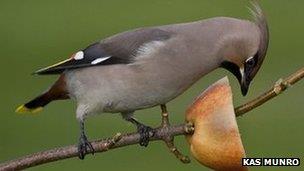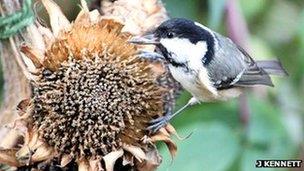UK garden bird feeding guide
Providing food for birds is one of the most helpful things you can do for your garden visitors, so long as you are thoughtful with your feeding.
The RSPB and the British Trust for Ornithology both suggest feeding birds all year round.
However, it is suggested that feeding birds during the colder months should be a priority.
Dawn and dusk are the key times of day to ensure there is food available, especially during these colder months.
Feeders and bird tables
Putting out a good mixed feed on bird tables and in feeders will encourage most urban birds into gardens, providing them with essential energy.
It is also important to provide the birds with access to clean water to drink and bathe in and bird baths should be regularly cleaned.
Feeder hygiene is also very important. Check out our 10 best kept garden bird secrets for more information.
Additional feeding can be done throughout the year but is particularly important in winter and spring.
Parent birds will be in desperate need of food in spring, when they have to provide for their young as well as themselves.
Winter is the hardest time of year for all our wildlife to survive due to scarcity of food. Fat balls [seeds mixed with fat] will be popular additions to your feeding stations and are readily available to buy.
Some come in a nylon mesh bag but always remove these because birds get their claws caught in the mesh, causing injury and potentially trapping them.
As a cheaper option you can make your own. Pop seeds and dry mealworms into your fat feeder mix to add protein and carbohydrate.
Never use polyunsaturated fat or butter as these can cling onto birds' feathers.
Only use these in the winter as warmer temperatures will melt the fat, causing it to go off.
You could also put out some finely chopped unsalted bacon rind or grated hard cheese to provide energy-rich fat for your birds.
Mealworms
 Mealworms are an excellent source of protein for your garden visitors
Mealworms are an excellent source of protein for your garden visitors
Live mealworms are packed with protein and moisture and are an excellent bird food, quickly attracting birds such as robins and thrushes.
In spring, busy parents are desperately foraging to feed their growing chicks so if you can, put out live mealworms.
However, dried mealworms are also very good, just soak in water before putting them out to provide birds with valuable moisture.
Avoid using discoloured worms which may carry diseases such as salmonella.
Fruit
Fruits are another great bird food as they have a high water content and are energy-rich with all their simple sugars.
Thrushes, blackbirds and winter migrants such as waxwings will all enjoy your left over windfalls
Fruit such as apples, pears and plums can be halved and left on either the bird table or ground for the robins, blackbirds, and thrushes to enjoy.
If you have any fruiting trees or bushes, by leaving some of the windfall fruit, you have just provided food for birds through the summer and autumn.
You could also store windfall apples and pears somewhere dry and cool like your garden shed to then put out in winter.
Peanuts
Being high in fats and protein, peanuts are a favourite with tits, finches, nuthatches and woodpeckers.
However, be sure to buy them from a reputable supplier to avoid harming the birds.
Avoid salted peanuts as most birds can not process the salt and may die from ingesting too much.
Try not to leave out whole peanuts in the spring unless they are in a wire mesh feeder, as busy parents may feed them to their young, potentially choking them.
Crush them up and the problem is solved - it will also attract robins and dunnocks to feed on them too.
Push some peanuts into holes drilled into old logs or branches to set a challenge for your nuthatches and woodpeckers.
Sunflower seeds
 Many birds adore sunflower seeds
Many birds adore sunflower seeds
Many birds are attracted to sunflower seeds as they are rich in protein and unsaturated fats.
Whole seeds provide more natural foraging but be aware that it requires substantially more effort for the birds to remove the husks.
Putting out sunflower hearts or kibbled (crushed) seeds from late autumn through to spring when times are hardest saves them spending unnecessary effort.
Coconut
Drain and then cut open a fresh coconut and hang it up for tits. Once the coconut has all been eaten the remaining shell can make a great container for home-made fat balls or other seeds.
Avoid putting out desiccated coconut as this can swell up in birds' stomachs making them very ill.
Nyjer seeds
Finches and siskins relish nyjer (niger) seeds
Rich in fat, nyjer seeds are a favourite of finches.
However, they are tiny and will fall straight through most feeders.
Either mix them with other seeds in a plastic feeder, stir them into your fat ball mix or put them on a tray or special nyjer seed feeder.
Leftovers
Dried fruit, unsalted bacon rinds, cooked rice, spare dog or cat food, leftover grated cheese and the remnants from the bottom of your cereal packet can all be left out for birds, so long as they are finely chopped.
Avoid fat from cooked meats as this smears in a way which is not good for birds' feathers.
Biscuits should be crushed and soaked where possible to avoid choking birds and to add moisture.
Never give birds milk as they cannot digest it. Avoid cooked oats but uncooked are fine.
Wildlife-friendly gardening
Investing in certain plants will provide natural food sources for your birds either directly with fruits and seeds or indirectly by attracting insects and invertebrates.
Woodpigeons, thrushes and blackcaps love these winter treats
A range of flowering and fruiting seasons is important - holly and ivy produce their berries in winter so planting these will help birds during the leanest times.
Stop birds such as robins going hungry over the winter by planting some spindle - their berries are a vital source of energy.
Remember: a weed is simply a plant that is growing in the wrong place.
Nettles are insect attractors and insects attract birds, so leaving a couple of patches of nettles out of the way will help bring birds to the garden.
Brambles require more gardening work to keep them in check but they provide wonderful fruit and excellent cover from predators for tits and other small birds.
Delaying your annual pruning of herbaceous and berry-bearing plants until late winter will allow the seed-loving birds their fill.
Leave it alone
However the easiest and cheapest way to provide food for birds and other wild visitors is to do nothing.
If you abandon using slug-killer and pesticides, birds and other wildlife will feed on the bounty of invertebrate snacks you have left for them.